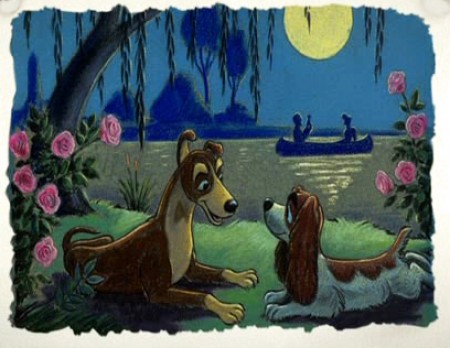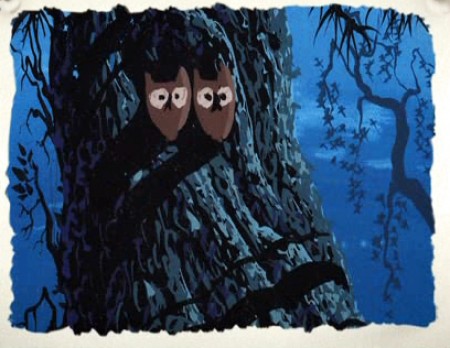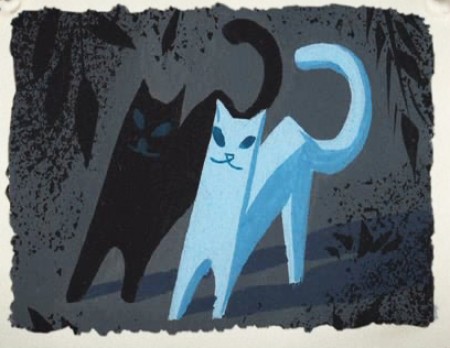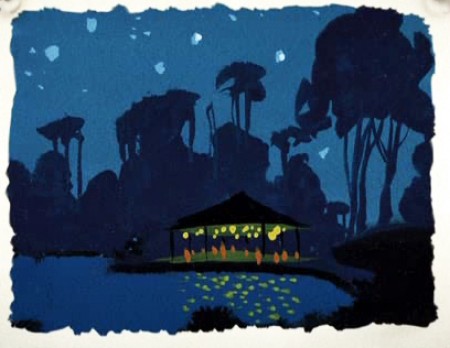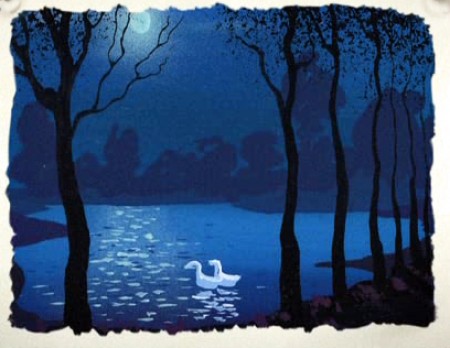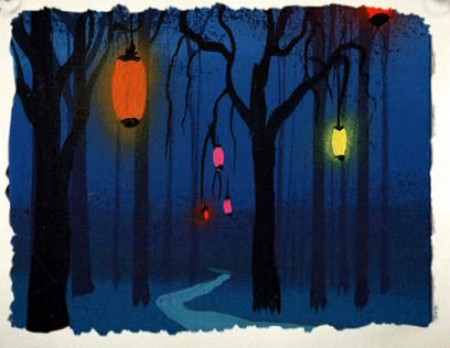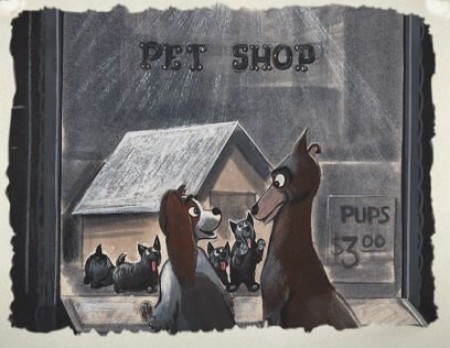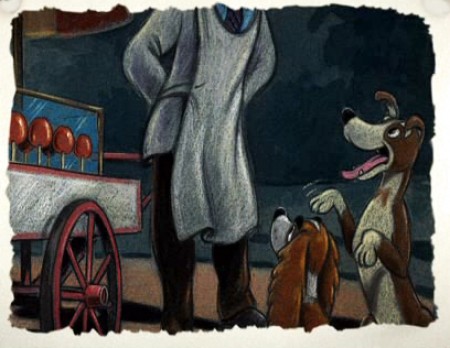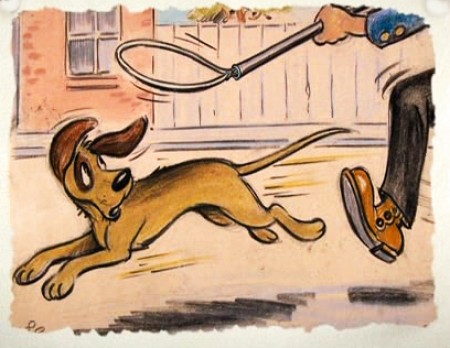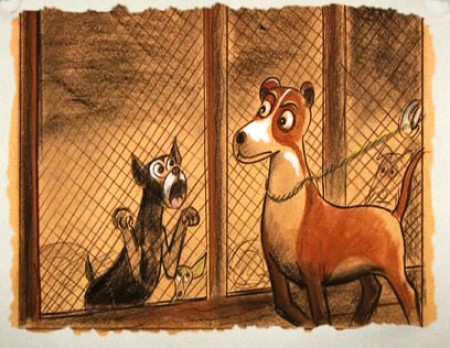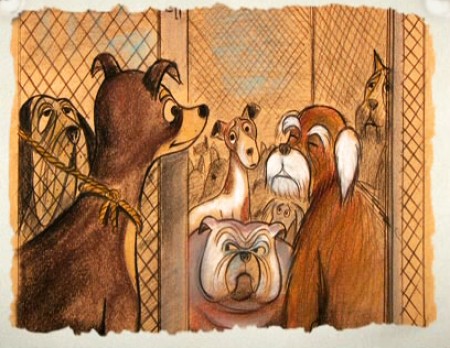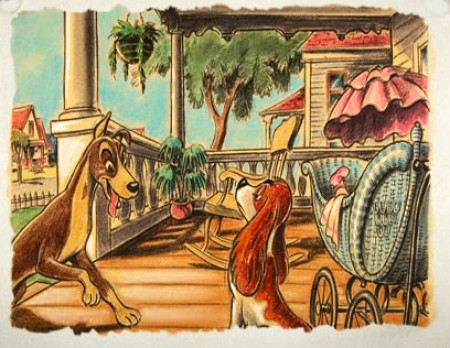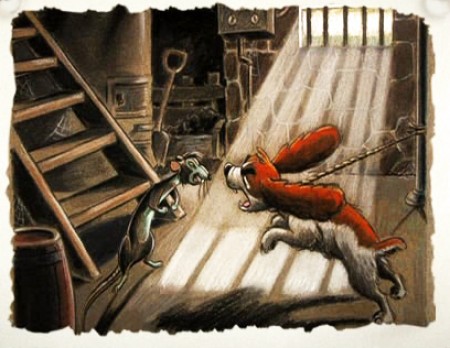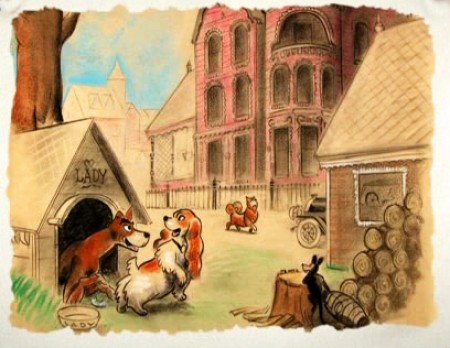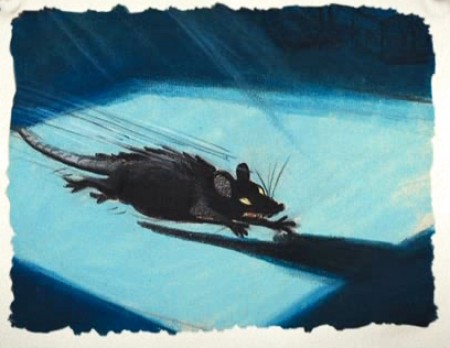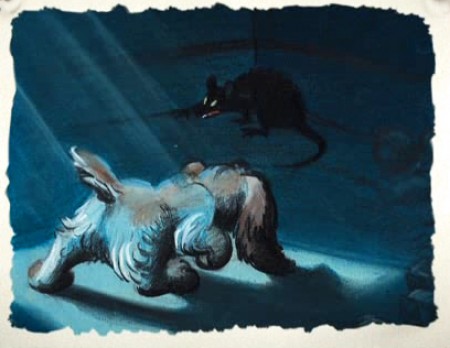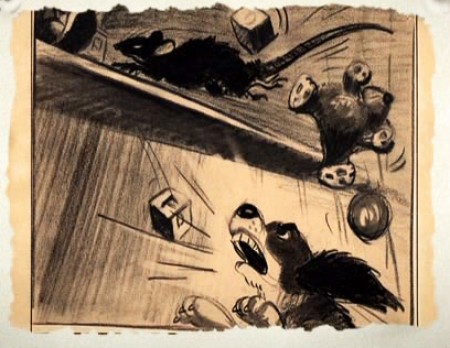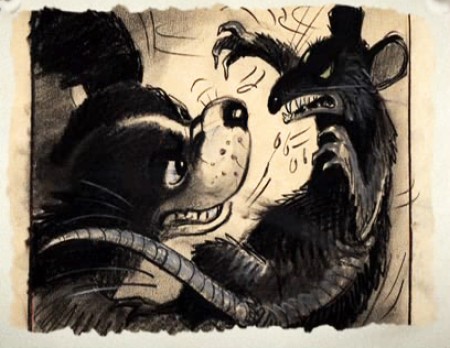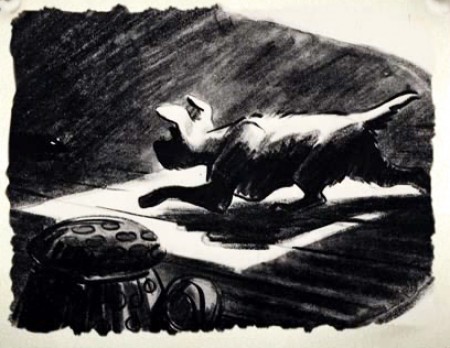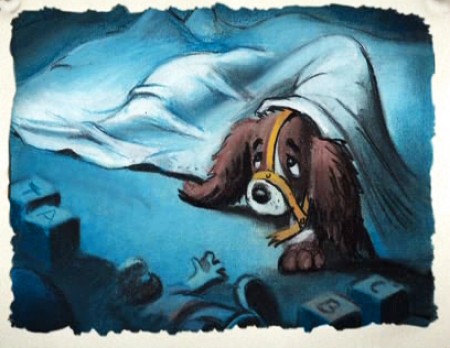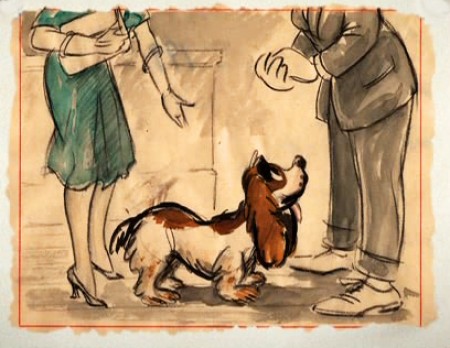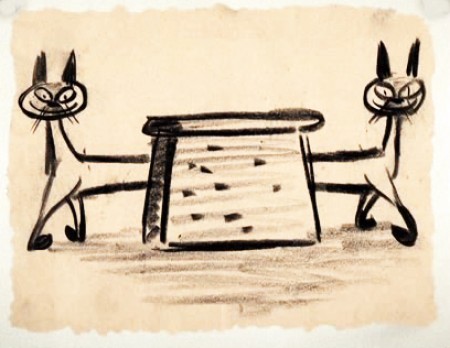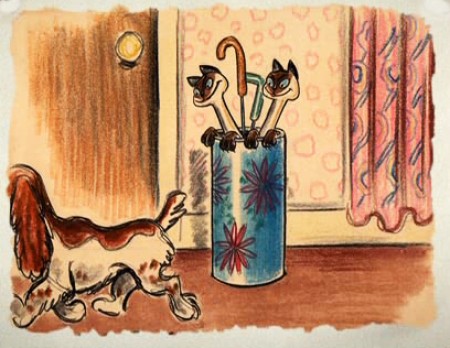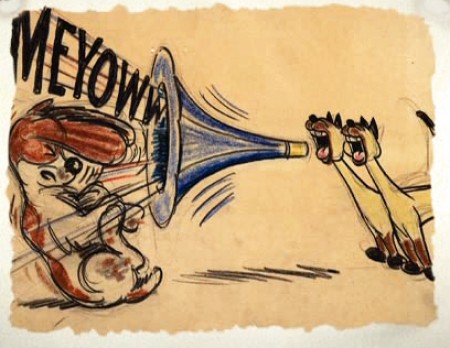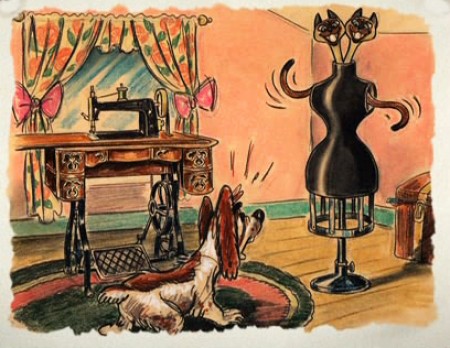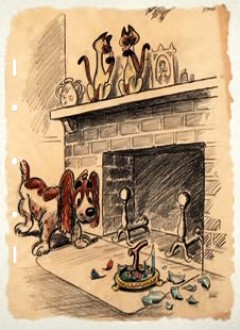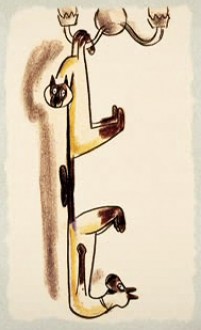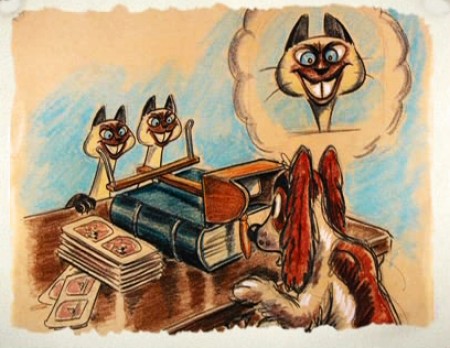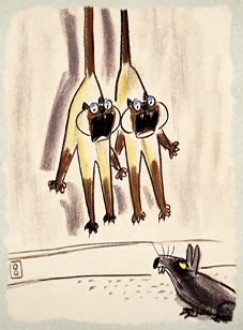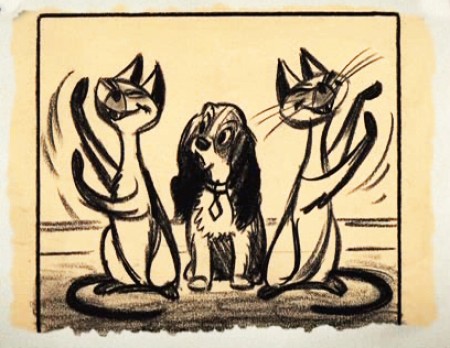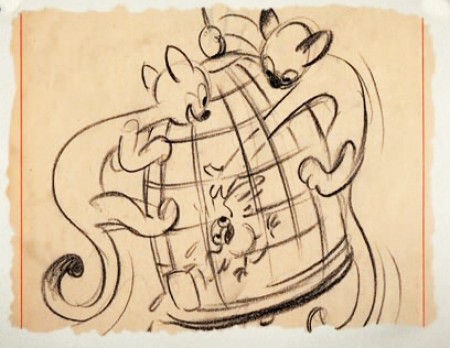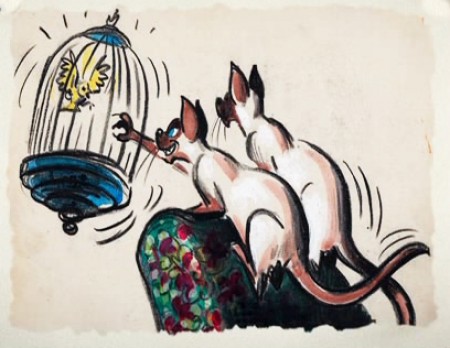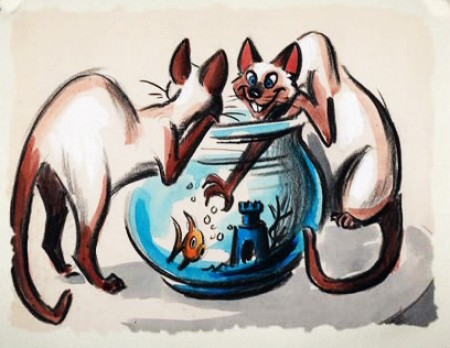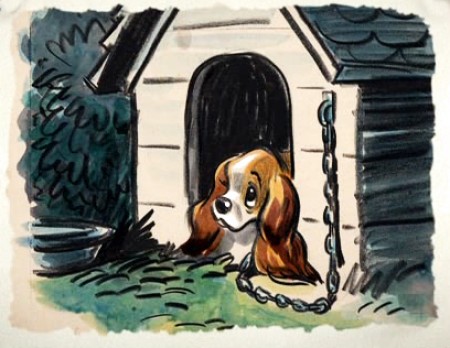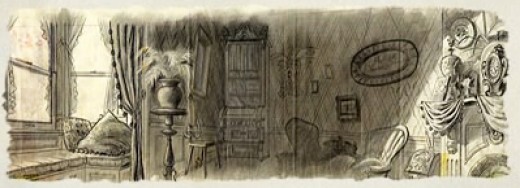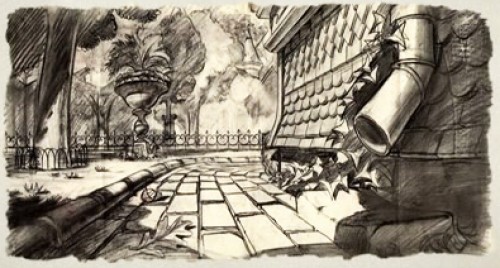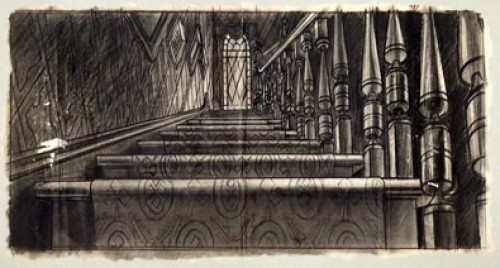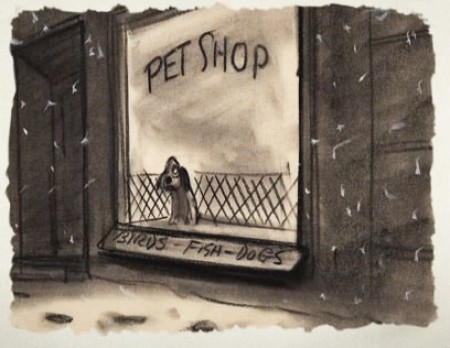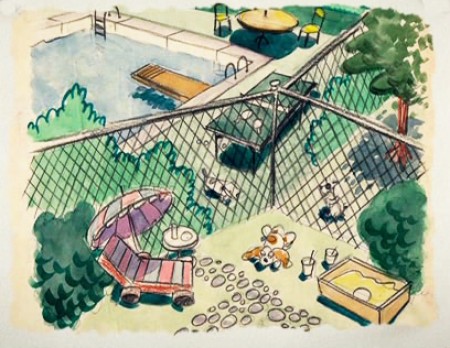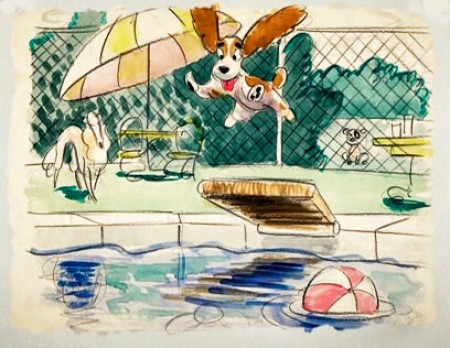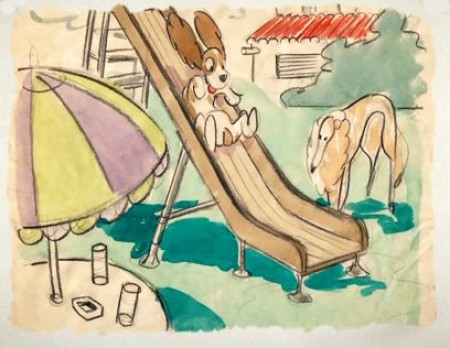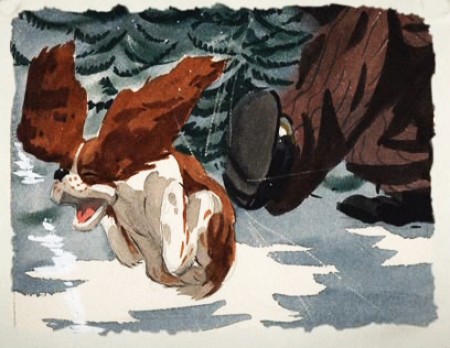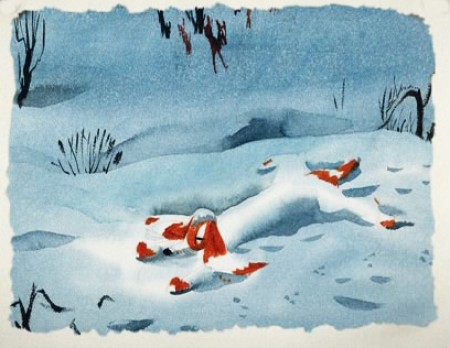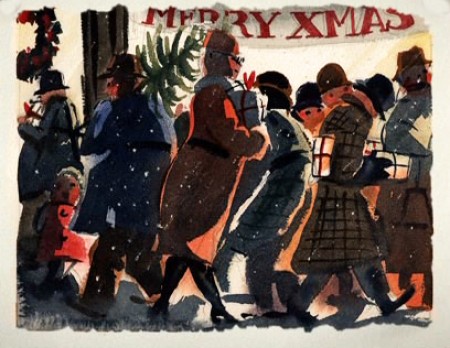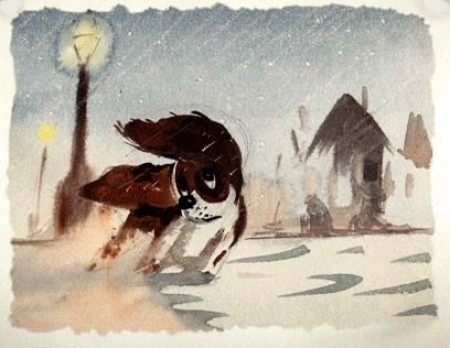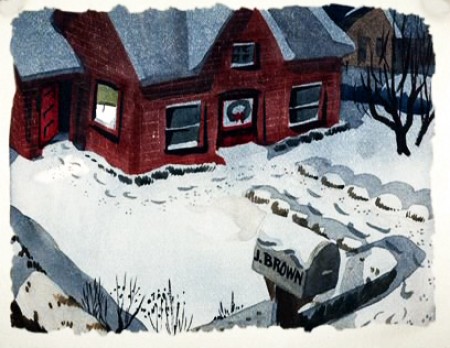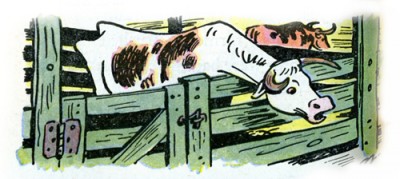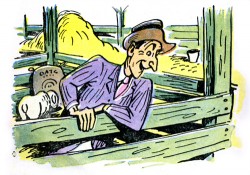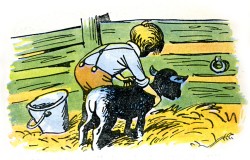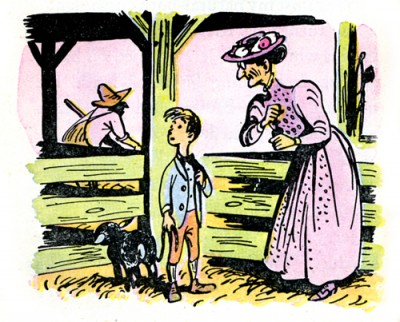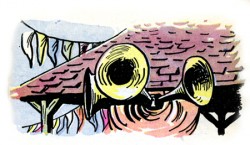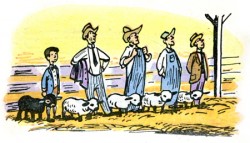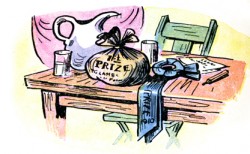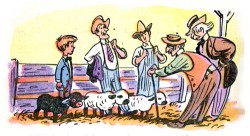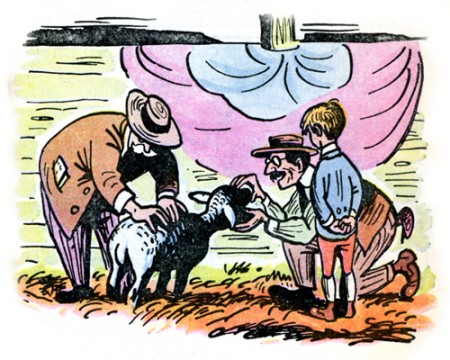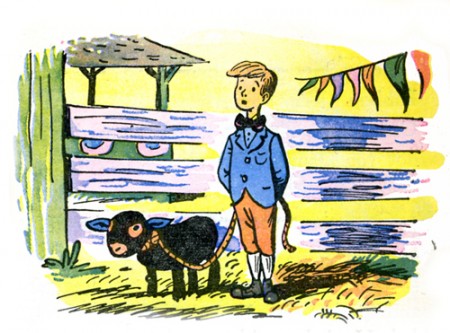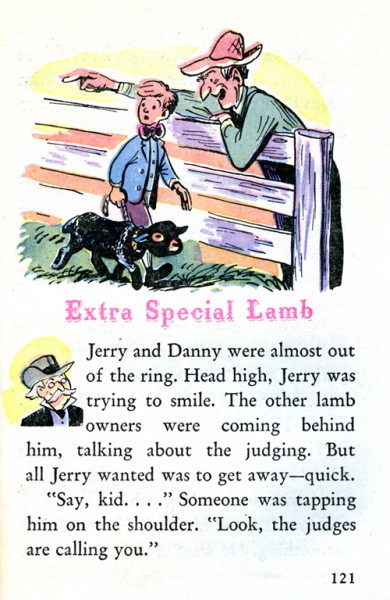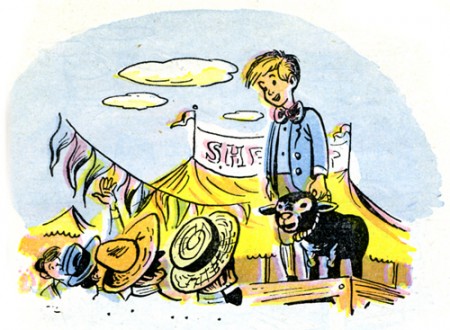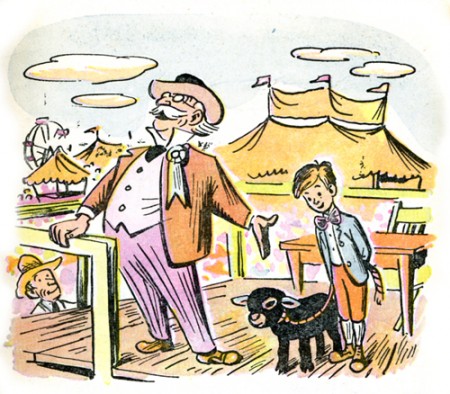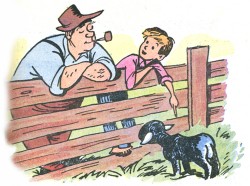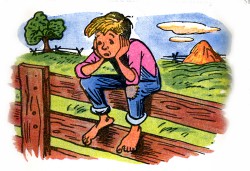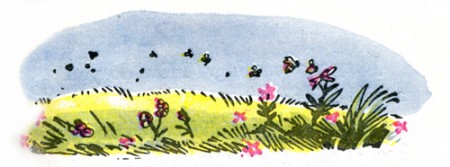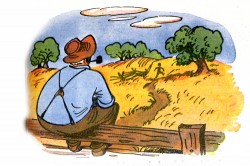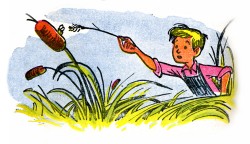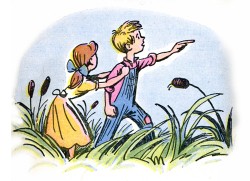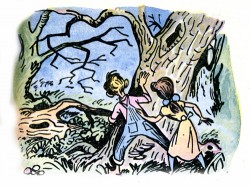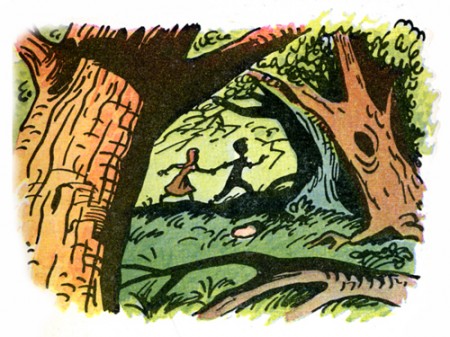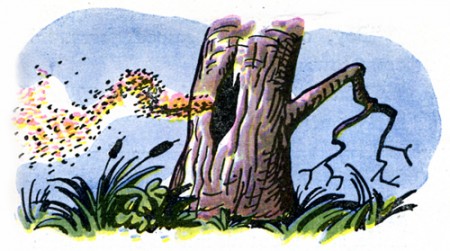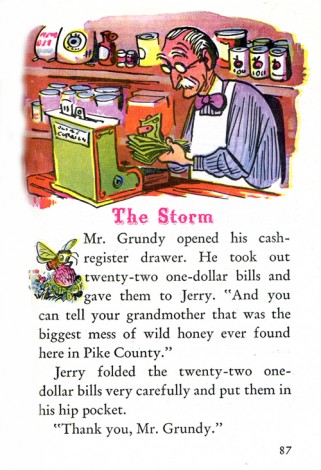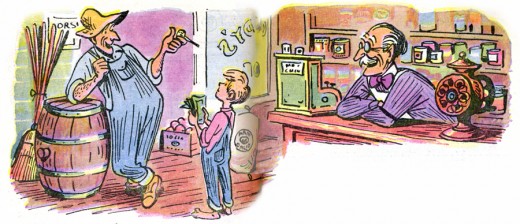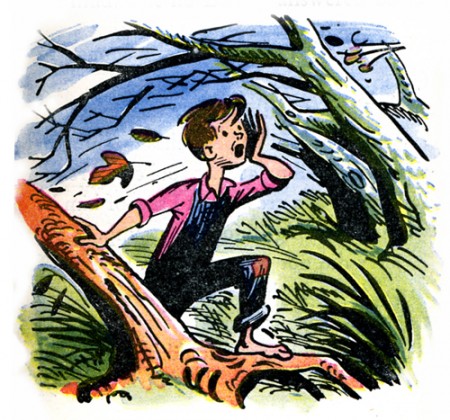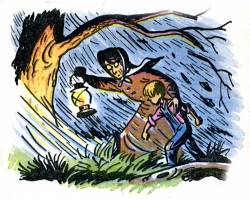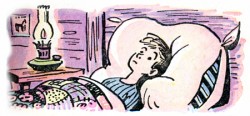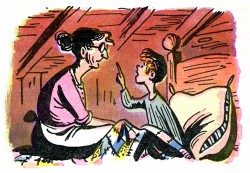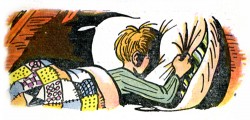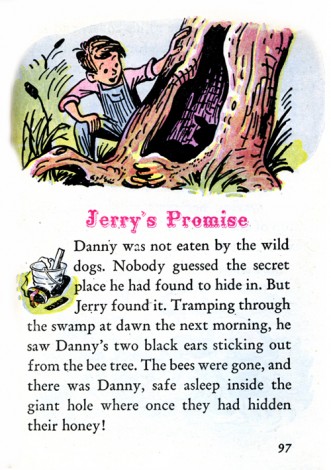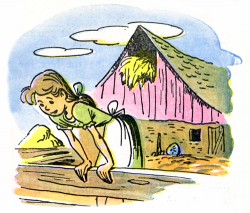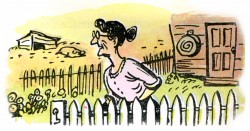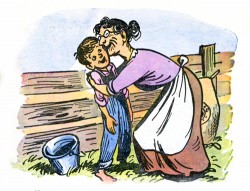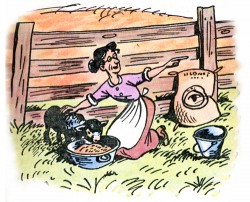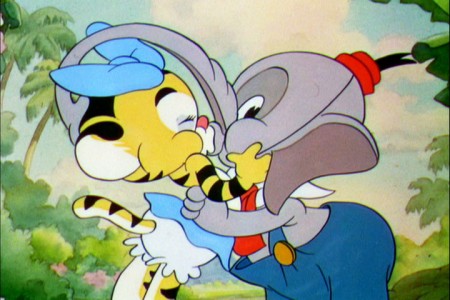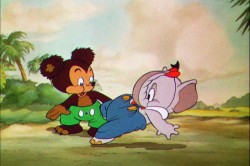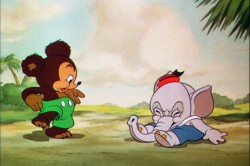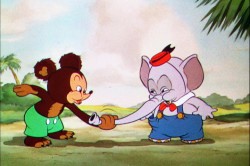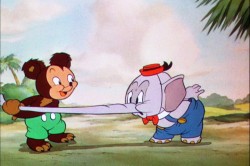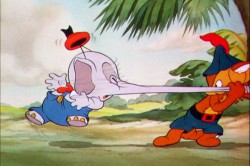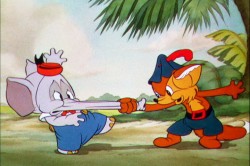Category ArchiveDisney
Animation Artifacts &Disney &Frame Grabs &Story & Storyboards 01 May 2009 07:33 am
Even More Lady drawings
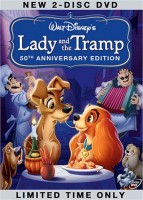 - I’ve been posting frame grabs from the recent DVD of Disney’s Lady and the Tramp. Unfortunately, they give these in such a small form that it’s hard to view them on the tv screen. Hopefully, this will give a better opportunity of seeing some of this artwork.
- I’ve been posting frame grabs from the recent DVD of Disney’s Lady and the Tramp. Unfortunately, they give these in such a small form that it’s hard to view them on the tv screen. Hopefully, this will give a better opportunity of seeing some of this artwork.
I have a couple of other small comments about these DVD’s in release today. Aside from the annoyance of these gallery drawings being offered at such a diminished size so that you can’t really study any of them, there’s also the problem that the artwork is not labelled in any way. God forbid they should promote the name of anyone who painted these images.
There’s also no commentary track anymore. If you go back to the not-very-special version of Dumbo, there’s one of the all-time-great commentary tracks. John Canemaker did it by himself, and by the time you get well into the film, you realize the depth of information you’re getting from John even though his relaxed and natural voice charms you. I have to say I’ve listened to this commentary four or five times.
There are plenty of other problems I have with these new “Special” productions that I won’t get into; regardless, here are the images I could get.
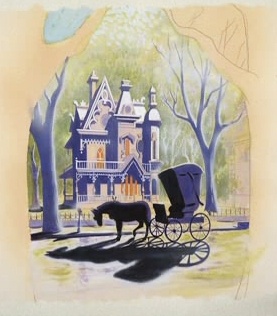
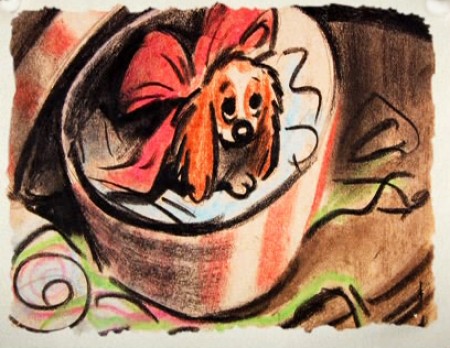
I’d say that you could enlarge the images if you clicked on them,
but unfortunately I’m even enlarging some of them with these thumbnails.
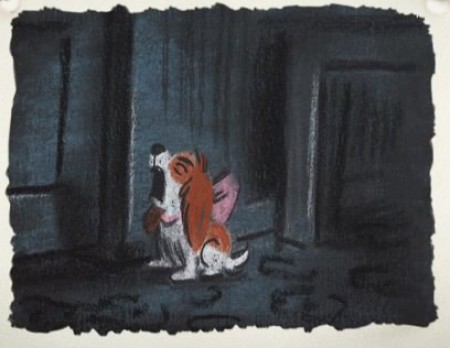
They’re such beautiful drawings/paintings to produce at so small a size.
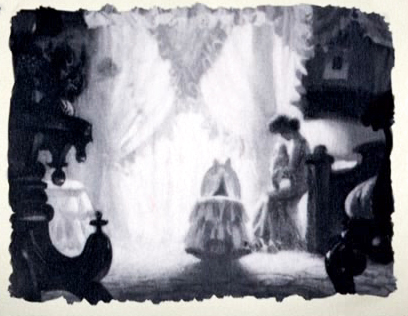
.
Animation Artifacts &Disney &Frame Grabs &Story & Storyboards 28 Apr 2009 07:33 am
Some More Lady drawings
-Continuing with some of the sketches done for Lady and the Tramp and found on the DVD extras gallery (in a somewhat tiny screen size), here are some more pieces by a number of different artists over a number of different years. They all exhibit a life of their own that’s pleasant to visit. Very cartoon compared to the film they made.
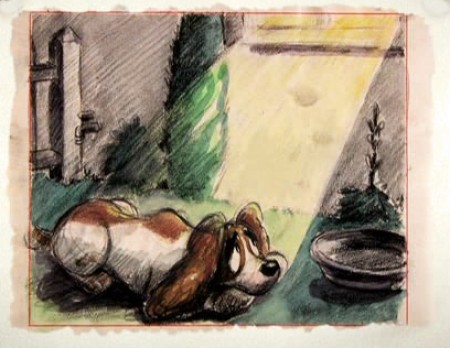
(Click any image to enlarge.)
One more post of these to go. On Friday.
.
Animation Artifacts &Disney &Illustration &Story & Storyboards 27 Apr 2009 07:46 am
Some Lady drawings
 - The recent DVD of Lady and the Tramp includes some preliminary artwork for the film. I collected a bunch of it and am breaking it into a couple of posts. It’s easier to read off a blog than a tv screen, especially when the DVD tries hard to reduce them to the smallest size they can muster within an overworked border that is virtually pointless.
- The recent DVD of Lady and the Tramp includes some preliminary artwork for the film. I collected a bunch of it and am breaking it into a couple of posts. It’s easier to read off a blog than a tv screen, especially when the DVD tries hard to reduce them to the smallest size they can muster within an overworked border that is virtually pointless.
The illustrations – some are obviously BG layouts, others storyboard drawings – have a light and jaunty feel. They’re very cartoon in nature, and belie the actual feature they produced which, at times, is quite beautiful. Disney truly got the feel of “Main Street, USA” in this film.
I’m interested that most of the images don’t take in Cinemascope (since they were probably done before the decision to go Scope.) Most of them are also fast drawings that don’t feature the Tramp as we know him, and even Lady takes on a different form.
You get the feeling this film was pushed out relatively quickly. The results are excellent, regardless. Sonny Burke and Peggy Lee wrote an excellent pop-song score that doesn’t quite capture the turn-of-the-century, but it does capture the atmosphere of early 50s USA.
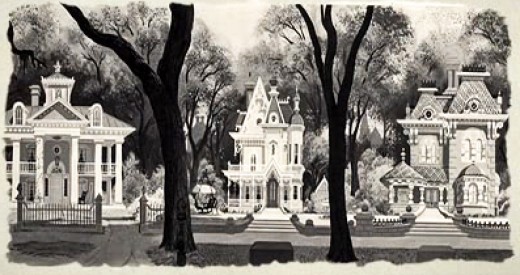
This drawing is in B&W on the DVD, but it appears in
Bob Thomas’ 1958 book, “The Art of Animation.”

Bg for The Princess and the Frog.
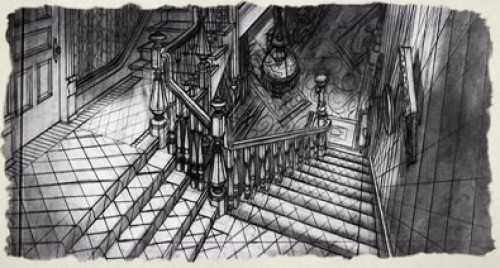
This looks not too different from a shot in Hitchcock’s Psycho.
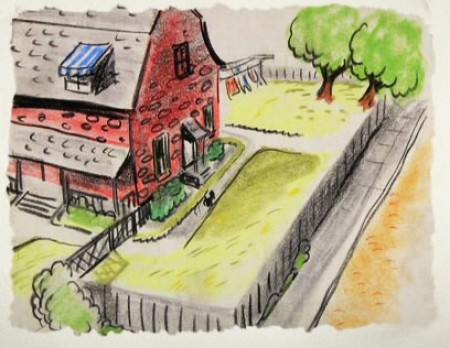
We seem to be in the Little Golden Book territory
with some of these images.
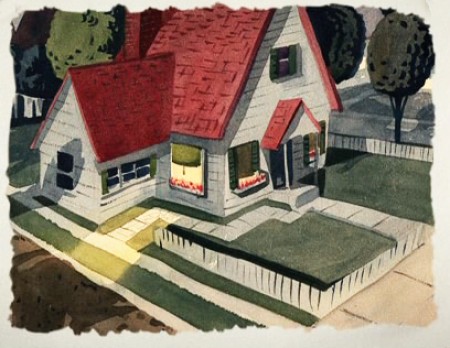
An earlier and different view.
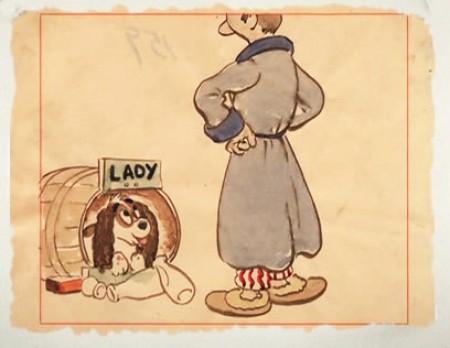
Or did I mean the New Yorker circa 1948?

I love weather and would have applauded more of it in the film.
To be continued tomorrow.
Books &Disney &Mary Blair 14 Apr 2009 08:16 am
Chouinard the Book
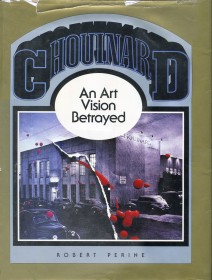 - I recently came upon an excellent book, Chouinard/An Art Vision Betrayed by Robert Perine published in 1986. This book is the history of the school that would become CalArts.
- I recently came upon an excellent book, Chouinard/An Art Vision Betrayed by Robert Perine published in 1986. This book is the history of the school that would become CalArts.
I suspect it’s more familiar to those on the West Coast than we on the other side of the continent. Regardless, the book well documents the connection between this art school and the Disney studio, particularly in the early days.
Here we’re treated to a good history of Don Graham, who led the Disney classes for Walt during the ’30s expansion movement. We also come upon students and teachers including all the famous names: Phil Dike, Virgil Partch, Hardie Gramatky, Retta Scott, Mary and Lee Blair, Ward Kimball and many others. We’re also treated to photos and artwork by these people. We also see a clear picture of the school’s founder, Nelbert Chouinard.
I’ve pulled a couple of photos and art pieces and a couple of paragraphs from the first chapter which I thought worth sharing.
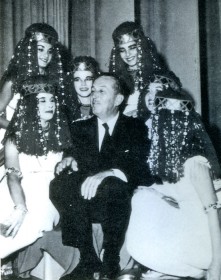 I made a deal with some of the teachers at Choulnard to come out and work with me, to sit with me by the day and know my problems. That, In turn, gave them the chance to know what we had to work on. They sat tight In the room with me; I picked Graham because he was more Life . . . figures and movement and things . . . simplification. So Graham sat with me In what we called our sweatbox. Fifty percent of my time was spent In the sweatbox going over every scene with every animator.
I made a deal with some of the teachers at Choulnard to come out and work with me, to sit with me by the day and know my problems. That, In turn, gave them the chance to know what we had to work on. They sat tight In the room with me; I picked Graham because he was more Life . . . figures and movement and things . . . simplification. So Graham sat with me In what we called our sweatbox. Fifty percent of my time was spent In the sweatbox going over every scene with every animator.
The sweatbox was an un-insulated projection room which Walt describes as “hot as the dickens,” where animators would come to sweat out Walts approval of their latest attempts. ‘They used to dread comin’ in… I’d just tear hell out of’em,” but this was all part of the learning process as both animators and studio head ____________Walt at Egyptian Ball – 1956
worked out the best solutions for making the
moving figure work. So Graham was soon a part of this process and carried Walt’s ideas back to his classroom.
Reciprocally, a bit of Graham (and Nelbert) rubbed off onto Walt as they worked together 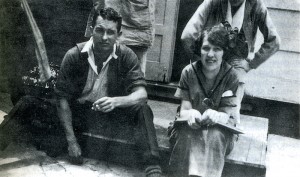 on the problems of animation. Said Walt:
on the problems of animation. Said Walt:
I set up a whole new thing (which Is) having Us effect now among the artists. We think of action. We think of drawing for action. We call It action analysis. You draw from a static figure when you’re In Life class. And your model’s sitting there. You’re draiumg the spinal column … the whole anatomy… _______Don Graham on the porch of the 8th St. School
but you don’t get any feeling of action.
So we have the model go through actions. She goes through It and then.. .sits over In the corner.. .and they sketch what they saw. What you see here (Is) not a literal copy of something. It’s.. .the Illusion you get.
Even before Walt had come to California — when he was only 19 — he had frugally photostated Muybridge’s now-famous movement photographs out of a borrowed library book, then cut them up and overlapped them in an attempt to analyze motion. But now it was a new kind of challenge — doing it with drawing. Walt further describes that challenge:
We’ve got to analyze the walk. So we would then photograph people going through actions… then we would study It. There were a lot of things I was able to get over that way. You’d have a running action. We’d draw. (It’d) be perfect because (we’d) be looking at that drawing Individually on the drawing board. (But) It doesn’t look that way; that’s what gave us stiff animation. Then we got the trick of blurting.. .In effect, elongating. When you’re moving fast Is when the action begins to take on a smoothness.. At wasn’t numbers of drawings. It’s how drawings are made.
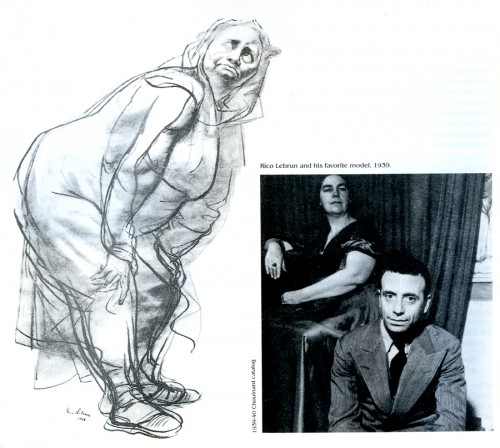
Rico LeBrun (who taught animal anatomy to the animators
at Disney during the making of Bambi) and his favorite model
-
The ideas that developed during Disney’s training period (1930-1940) were greatly aided by Don Graham. Eventually Walt hired him at Disney Studios as head of their own night school. So Nelbert’s influence and ideas were carried out into the professional world. In the animation industry alone Chouinard students and teachers like Graham, Dike, Caldwell, Davis, Gramatky, Fleury, Johnstone, Lebrun, Lee and Mary Blair, T. Hee, Plummer, and many others became important stimuli to the successful growth of the animated film.
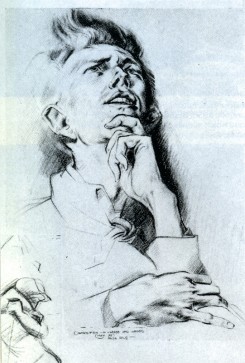
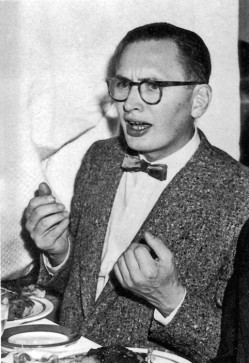
A drawing by Retta Scott | Virgil Partch at a Guild Meeting
The book is a treat. I’ll add more to this in a future post.
Art Art &Commentary &Disney 02 Apr 2009 07:50 am
SF Museum & Paul Glabicki gallery opening
 - Yesterday’s NYTimes featured an article about the forthcoming Walt Disney Family Museum to open in October in San Francisco. Former deputy director of the Harvard University Art Museums, Richard Benefield, will run the Museum. It’d be nice if a genuine animation historian were somehow involved.
- Yesterday’s NYTimes featured an article about the forthcoming Walt Disney Family Museum to open in October in San Francisco. Former deputy director of the Harvard University Art Museums, Richard Benefield, will run the Museum. It’d be nice if a genuine animation historian were somehow involved.
I enjoyed seeing the reason Diane Disney Miller gave for feeling the necessity of the museum. A 1994 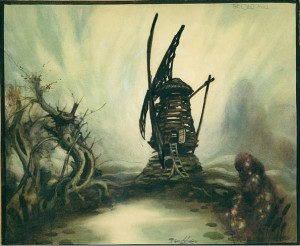 biography by Marc Eliot, “Walt Disney: Hollywood’s Dark Prince,†that depicted him as a bigot angered her. Neal Gabler’s book, “Walt Disney: The Triumph of the American Imagination,†also upset her. That book gave an unflattering picture of Disney’s marriage, despite the fact that the family opened all their records to Gabler.
biography by Marc Eliot, “Walt Disney: Hollywood’s Dark Prince,†that depicted him as a bigot angered her. Neal Gabler’s book, “Walt Disney: The Triumph of the American Imagination,†also upset her. That book gave an unflattering picture of Disney’s marriage, despite the fact that the family opened all their records to Gabler.
Ms. Miller also feels that the “Empire” has passed Walt over as a person in their attempt to globally brand the Disney name. Reportedly, this comment has confused the directors of studio Disney. After all, “. . . the company recently issued collectible figurines in his likeness and runs a fan club and magazine dedicated to him.”
Diane Disney Miller hopes the museum will portray a complete picture of her father, offering positive as well as not-so-positive material to the public. The museum will include, for example, a video about Disney’s friendly testimony before the House Un-American Activities Committee in 1947 and acknowledge the bitter animators’ strike in 1941.
Too bad the SF Chronicle won’t be around to give us a good report on the opening. Regardless, I’ll have to schedule a trip to the city to see this site once it opens. In the meantime, the Museum’s site is already up and running offering some bits of information and an operating book store (which doesn’t sell Gabler’s book, but does offer numerous John Canemaker tomes.)
- April 4th through May 9 Paul Glabicki will have a solo show in NYC at the Kim Foster Gallery, 529 West 20th St. in NYC.
Paul is a friend who came up through the film world at about the same time as I. His interest was always more into the experimental, Independent film, and his work was always exquisitely detailed and complex films. We often found each other at the same festivals in differing categories.
I received some information about his upcoming show, and I’m posting some of the information and statements that were sent me by the gallery.
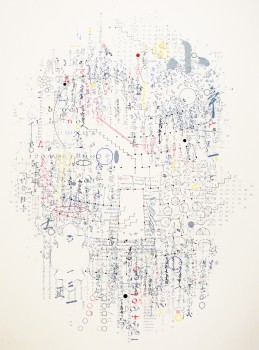 Paul Glabicki is an experimental film animator whose work has appeared at major film festivals, as well as national and international museum exhibitions. His animation work has been carefully crafted by means of thousands of meticulous hand-drawn images on paper. His films have screened at such prestigious sites as the New York Film Festival at Lincoln Center, the Cannes Film Festival, the Museum of Modern Art and the Whitney Museum of Art in New York, and the Venice Biennale. He has received numerous awards, grants, and fellowships, including a Guggenheim Fellowship. Grants from the National Endowment for the Arts, the Amencan Film Institute, and several grants from the Pennsylvania Council on the Arts.
Paul Glabicki is an experimental film animator whose work has appeared at major film festivals, as well as national and international museum exhibitions. His animation work has been carefully crafted by means of thousands of meticulous hand-drawn images on paper. His films have screened at such prestigious sites as the New York Film Festival at Lincoln Center, the Cannes Film Festival, the Museum of Modern Art and the Whitney Museum of Art in New York, and the Venice Biennale. He has received numerous awards, grants, and fellowships, including a Guggenheim Fellowship. Grants from the National Endowment for the Arts, the Amencan Film Institute, and several grants from the Pennsylvania Council on the Arts.
His new drawing series titled “ACCOUNTING for…” began with a Japanese artifact acquired by the artist several years ago: an accounting ledger book dating from the 1930s.
The relentless record keeping, the beauty of the mark-making, musings about its contents and purpose, the fact that it survived and came into his possession, the patterns that emerged when the book was carefully taken apart and arranged on a wall, the suggestion (by changes in the writing style) that more than one person made the marks, and other thoughts, images, and responses grew out of the artist’s interaction with the book.
Paul was interested in the book as a found personal, temporal object imbedded with meaning, function and mystery. Most intriguing to him was the fact that it made a leap from past to present written day-by-day; month-by-month, entry-by-entry, mundane and utilitarian (not intended to be an aesthetic object), recorded in time, and revealing patterns and rhythm over the duration of its writing.
The opening reception is Saturday April 4th 6-8pm.
You can see a 10 min short by Paul, Object Coverstion, on YouTube here.
Books &Disney &Peet 18 Mar 2009 08:06 am
So Dear #5
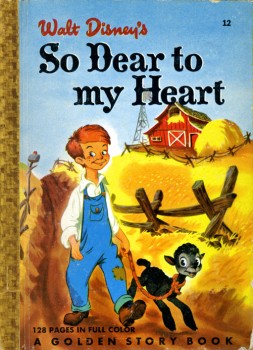 - Here’s the conclusion to the Little Golden StoryBook, So Dear To My Heart. The book is an adaptation, of course, of the movie by Helen Palmer with illustrations by Bill Peet.
- Here’s the conclusion to the Little Golden StoryBook, So Dear To My Heart. The book is an adaptation, of course, of the movie by Helen Palmer with illustrations by Bill Peet.
At 128 pages, the book is quite long and chock full of gems by Bill Peet. It’s one of his first publications and shows a lot of the hallmark look he’ll have once he bagan writing and illustrating his own books, although they’re considerably shorter (averaging about 30 pages.) These ink and watercolor illustrations are all spot drawings and fill usually about a third of the page. The colors are limited with an inexpensive printing process used on inexpensive paper. At 5″ x 7″, the book is also a bit smaller than the usual Golden Book.
Here are the last two chapters:
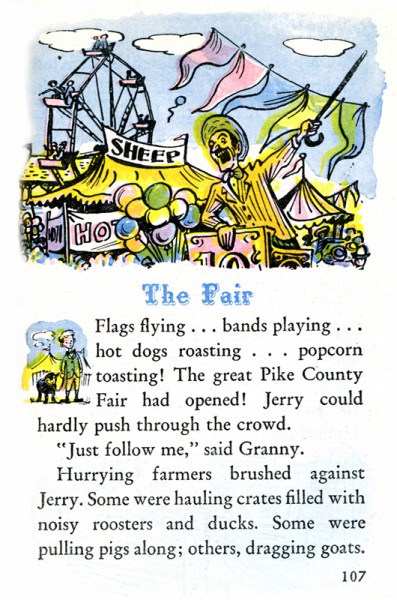
(Click any image to enlarge.)
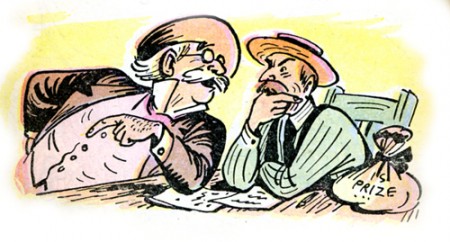
This drawing, alone, is worth the entire book. It’s beautiful and shows
Peet’s brilliance at capturing characters in a specific moment of time.

Most illustrators would probably have ended the book on this image of
the grand prize winner – such a temptation, the climax of the book.
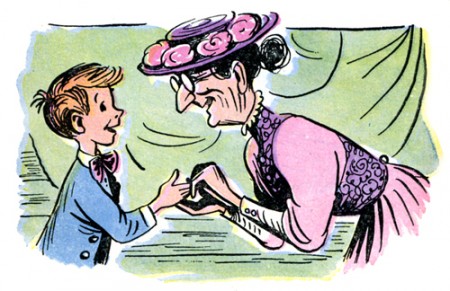
Peet is character driven and knows that the book is about the boy.
The last image has to be a shot (did I say shot? this isn’t a film. I meant
to say) picture of the real hero of the story . . . the boy.
Articles on Animation &Disney 14 Mar 2009 08:12 am
After Walt
- Didier Ghez on his site Disney History recently posted an article about life at the Disney Studio after Walt’s death in 1966. There were quite a few such articles during this period, and we were made to hope something would happen to generate life into the animation division of a company that was turning out bad films.
Time Magazine had the following article in their Aug. 16, 1979 issue:
CORPORATIONS
Running Disney Walt’s Way
When lung cancer killed Walt Elias Disney a decade ago, there were fears that the world of Disney would lose some of its wonder—and its profits. But before his own death in 1971, Roy Disney, who succeeded his younger brother, and a cadre of post-Walt executives had turned Walt Disney Productions into a thriving empire of fantasy. Today the company is bigger and richer than ever. Profits flow in from Disney’s two successful theme parks, Disneyland in California and the magic kingdom at Walt Disney World in Florida, from film rentals and television, from re-releases of such longtime favorites as Bambi, Pi-nocchio and Fantasia, and from sales of record albums, Mickey Mouse wrist-watches and everything else bearing the Disney stamp.
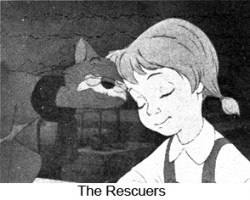 Last year the various forms of escapism earned Disney nearly $62 million on sales of $520 million—four times the total in 1966 when Walt died. For the first nine months of its current fiscal year, Disney was flying higher than Dumbo the elephant. Corporate profits were up 30%, and sales rose 16%. More than 6 million people flocked to Disneyland (which turned 21 in July), another 9 million to Disney World. The fifth re-release of the animated Snow White and the Seven Dwarfs, which came out in 1937, will gross an estimated $10 million in the U.S. alone by the end of this year.
Last year the various forms of escapism earned Disney nearly $62 million on sales of $520 million—four times the total in 1966 when Walt died. For the first nine months of its current fiscal year, Disney was flying higher than Dumbo the elephant. Corporate profits were up 30%, and sales rose 16%. More than 6 million people flocked to Disneyland (which turned 21 in July), another 9 million to Disney World. The fifth re-release of the animated Snow White and the Seven Dwarfs, which came out in 1937, will gross an estimated $10 million in the U.S. alone by the end of this year.
Analysts’ View. No one questions that Disney has come a long way since the studio gambled $1.5 million on Snow White. But Wall Street analysts insist that the company should be doing even better and are hypersensitive to any developments that could remotely be considered adverse. Last month, for example, Disney stock fell several points (to around $50, or more than 20 times earnings) because third-quarter earnings, though a record $19 million, were not up to Wall Street’s expectations. Says a Disney vice president: “That’s a source of irritation around here. They seem to run in a pack on the Street.”
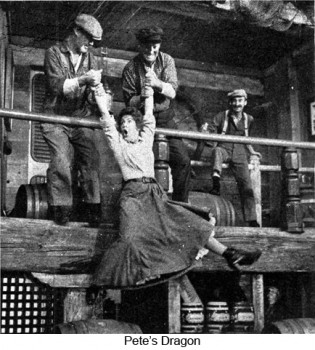 The founder’s ideas still run the show: almost everything Disney is now into was conceived of by Walt. “That’s the way Walt would want it” is a refrain heard frequently in the stucco Disney headquarters in Burbank, Calif. The executive most responsible for sticking to Walt’s winning formulas is E. Car-don Walker, 60, who joined Walt as a camera operator in the 1930s and has been Disney president since 1971. A tall, husky man whose use of profanity is limited to an occasional G-rated “damn,” Card Walker occupies an unpretentious office on the Disney lot not far from Dopey Drive and Mickey Avenue. His only concessions to the Hollywood movie mogul image are tinted glasses and a sleek gray Porsche (license plate: CAR WIN).
The founder’s ideas still run the show: almost everything Disney is now into was conceived of by Walt. “That’s the way Walt would want it” is a refrain heard frequently in the stucco Disney headquarters in Burbank, Calif. The executive most responsible for sticking to Walt’s winning formulas is E. Car-don Walker, 60, who joined Walt as a camera operator in the 1930s and has been Disney president since 1971. A tall, husky man whose use of profanity is limited to an occasional G-rated “damn,” Card Walker occupies an unpretentious office on the Disney lot not far from Dopey Drive and Mickey Avenue. His only concessions to the Hollywood movie mogul image are tinted glasses and a sleek gray Porsche (license plate: CAR WIN).
Walker believes that “the biggest challenge we face is still to make top-quality films,” and film critics tend to agree. Though slick and successful, the recent crop of Disney animated and live-action films (Gus, Treasure of Mate-cumbe, Robin Hood) shows little of Walt’s skill at tugging an audience over pop-emotional peaks and valleys. Nor do the forthcoming The Rescuers and Pete’s Dragon. Indeed, not since Mary Poppins in 1964 has Disney produced a genuinely smashing, supercalifragilisti-cexpialidocious hit.
This fact troubles Walt’s corporate heirs. Says Walker: “I don’t know exactly what it is. We don’t cut costs. Based on the quality of people involved in the film making, I would just have to say that we do our best.” Others blame excessive reverence for the traditional Disney method of moviemaking: batteries of cartoonists working under a rigid discipline on a single project for as long as three years. Says one young artist-animator who worked briefly for Disney: “The work is too confining. There’s not enough room to use your creative talents. It’s sterile.”
More and more, Disney is setting its animators to work on gutsier movies that seize audiences instead of rocking them to sleep. One feature in the storyboard stage, The Hero from Otherwhere, is about two schoolboys who find themselves on a strange planet whose black leader persuades them to help destroy a wolf that has been ravaging the land. Another, Spacecraft One, about a mile-long spaceship in its search for life on other planets, is Disney’s most elaborate sci-fi undertaking since 20,000 Leagues Under the Sea. The Black Cauldron, still in the treatment-writing stages, is about a pig keeper’s struggle with a villain whose shtick is regenerating an army of warriors from dead bodies—a long way from Poppins. Sex and excessive violence still are taboo on the Disney lot, but Walker foresees increased sophistication as younger animators reflect contemporary themes.
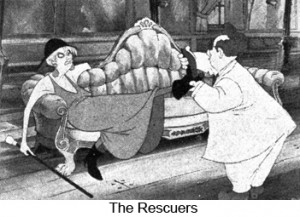 Non-film projects, however, account for three-fourths of Disney revenues and therefore generate the greatest excitement in the Disney organization. With Disneyland and Walt Disney World booming, the company is now moving on the biggest of Walt’s ideas: EPCOT, or Experimental Prototype Community of Tomorrow. To be built by the early 1980s in Florida as an expansion of Disney World, EPCOT will be a living laboratory of applied technology in transportation, housing, communications and waste disposal. Near it will rise the World Showcase, a permanent World’s Fair. Still another theme park. Oriental Disneyland, now planned to open late in 1979, will border Tokyo Bay in Japan; the Disney people expect it to draw 10 million visitors annually at the tourist hub of Asia. Estimated cost: about $175 million—most to be borne by the Japanese.
Non-film projects, however, account for three-fourths of Disney revenues and therefore generate the greatest excitement in the Disney organization. With Disneyland and Walt Disney World booming, the company is now moving on the biggest of Walt’s ideas: EPCOT, or Experimental Prototype Community of Tomorrow. To be built by the early 1980s in Florida as an expansion of Disney World, EPCOT will be a living laboratory of applied technology in transportation, housing, communications and waste disposal. Near it will rise the World Showcase, a permanent World’s Fair. Still another theme park. Oriental Disneyland, now planned to open late in 1979, will border Tokyo Bay in Japan; the Disney people expect it to draw 10 million visitors annually at the tourist hub of Asia. Estimated cost: about $175 million—most to be borne by the Japanese.
Double Duty. Whatever its problems, Disney has perfected one talent that other Hollywood fantasy factories envy: piggybacking. The familiar cartoon characters boost attendance at the theme parks, and the parks increase attendance at the movies. Though no one at Disney claims to be Walt’s equal in artistry or dreaming, Card Walker has made Disney’s characters do double duty as stars and as barkers to all the world. As a merchandising idea, it has proved to be almost as successful an inspiration as the original Mickey Mouse.
Books &Disney &Illustration &Peet 11 Mar 2009 08:00 am
So Dear #4
 - This is my fourth installment of Bill Peet‘s illustrations for the Little Golden Book adaptation of the Disney feature film, So Dear To My Heart. The book was written by Helen Palmer and is much longer than other Little Golden Books. It’s novella length and includes many short stories built on the film’s original story.
- This is my fourth installment of Bill Peet‘s illustrations for the Little Golden Book adaptation of the Disney feature film, So Dear To My Heart. The book was written by Helen Palmer and is much longer than other Little Golden Books. It’s novella length and includes many short stories built on the film’s original story.
I believe it’s the first book Bill Peet illustrated, and it led the way to a very successful career after he left Disney’s in the 60s. In his autobiography, Peet doesn’t mention this book. He talks about writing Lambert, the Sheepish Lion as his first potential children’s book. Obviously, he sold that to Disney instead of selling it as a book.
All illustrations are drawn with ink and painted with watercolor. THe printing is done on cheap paper, and the inks have obviously saturated the paper.
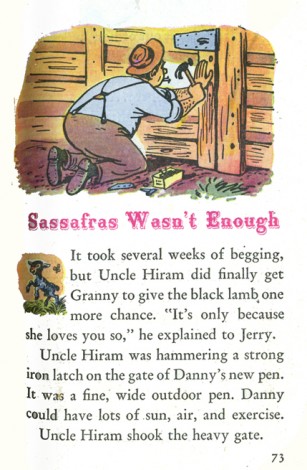
(click any image to enlarge.)
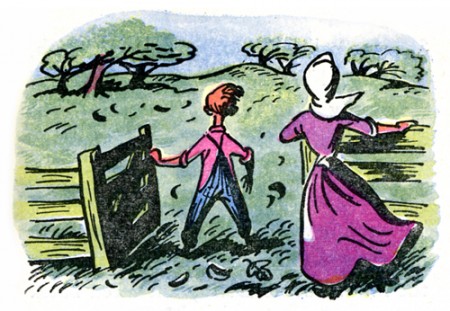
There’s something iconic about this image which
strikes a chord with me.
There are two more chapters to go, so one more post. It’s certainly turned into much more work than I’d expected. It should be complete later this week.
Animation Artifacts &Commentary &Disney 05 Mar 2009 09:07 am
Elmer Elephant
- The post on exposure sheets drew a lot of attention, which is something that pleased me. Perhaps there’s enough interest in the heart of the medium to keep it alive.
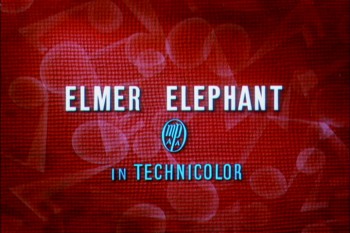
Robert Cowan sent me an exposure sheet that was tucked into an envelope in the Ingeborg Willy Scrapbook, which he owns. (Ingeborg Willy was an inker working at Disney’s during the 30′s and made a photographic scrapbook of her stay.)
The sheet is from the Silly Symphony, Elmer Elephant (1935).
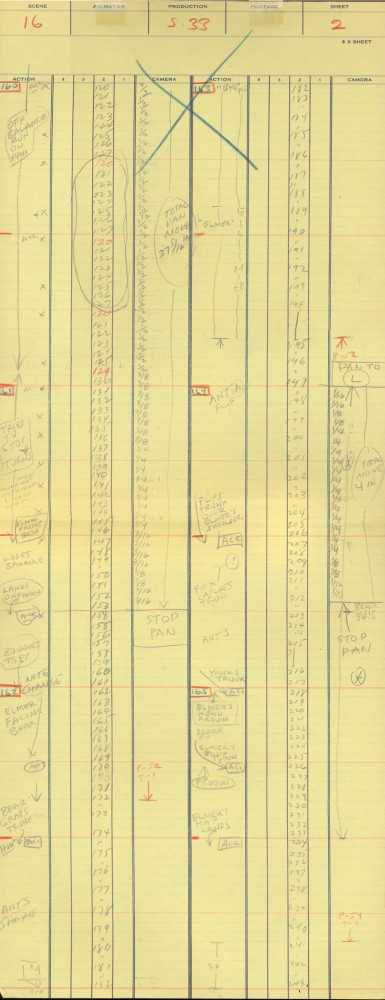
(Click any image to enlarge.)
The film’s about a bunch of baby animals.
Elmer is the shy kid who gets laughed at by the other kids.
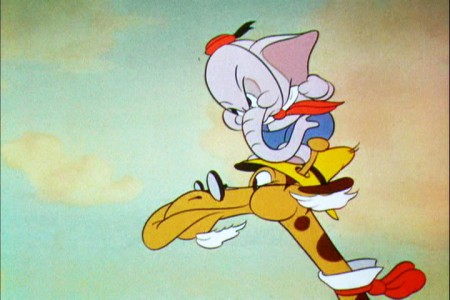
Eventually with the help of an old giraffe he saves the day by putting out a fire …
This exposure sheet is about a sequence wherein Elmer is pushed across a row of animals and is poked and prodded in absolute humiliation.
Let’s review what’s on the sheet for the completely unitiated viewer:
There are several columns: Action, 4,3,2,1 and camera.
These are basic to all X-sheets. Sometimes you get 5 numerals, oftentimes you get a column for Bg. Uusaly there’s also a Track column.
Below these descriptives you have lines. Each light blue line represents one frame of film. If the drawing’s on twos or threes or more it’s indicated as in #149. Other numbers are on ones – one frame per drawing.
In the “Action” column, the director writes notes telling where he wants some action to happen. For example: the director has noted that he wants Elmer to try to stop his turn from frames 32 through 49. The animator will follow this as best as possible.
The numbered columns represent cel levels. #1 is the bottom cel and #4 is the top cel. Most sheets also have a column for the Background so you know what number Bg is called for.
The “Camera” column indicates any special camera movements or effects. There we see a pan. The Bg is moving from screen right to left. The actual amount of the physical movement is indicated on every frame. 1/2 is a half inch, 1/4 is a quarter inch etc. Pans usually slow down as they come to a stop and gear up when they start out. This is why it goes from 1/2 to 3/8 to 1/4 to 3/16 to 1/8 to 1/16 before you reach STOP PAN.
You’ll see the sound track indicated at red marked 163 top line middle of the sheet. A character is saying, “Bye Elmer.” The actual number of frames it takes is broken down for you. The animator would animate the mouth accordingly.
Here are frame grabs for the part exposed.
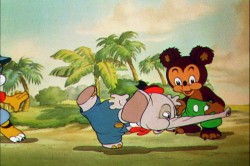 1
1 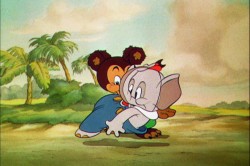 2
2
Let’s analyze the exposure sheet a bit. (For those not familiar with X-sheets, I have more of a breakdown below.)
First off, for me it’s an oddity. There seem to be two sheets combined onto the one. It’s split down the middle into two full sheets – all using only one cel level.
Secondly, there are some highlighted numbers – 160 through 165.
These fall at every 32nd frame. I’m not sure why. It’s not a foot (16 frames) or a second (24 frames). Is it a beat? I notice that the action calls for “ACC” at each of these markings. I assume it stands for “Accent” which would make that part of a musical tempo. Every 16th frame is also marked in red. This would be the only indication that this is what it is.
The pan moves are indicate in FRACTIONS ! I’m not sure why since it created a difficult transposition to decimals for the camera operator. I mean 3/8 of an inch equals what? Quickly now. Time is money. How about 1/16th? I have only met fractions which divided into 20ths. When did the change come in? John Oxberry, anyone?
Of course, some master checker would probably do the math before the scene got to camera.
Some of the drawings are exposed on twos, even for a short bit during the pan. This would be anathema in modern day animation, yet it hasn’t gotten better.
The track reading isn’t the most detailed I’ve seen, yet it does the job, doesn’t it?
The film is directed by Wilfred Jackson. I assume the “Action” column was filled out by him. I think the animation was by Paul Hopkins.
There’s a lot of information that can be pulled out from this one exposure sheet of a film done 73 years ago. Is that enough reason to advocate for continued use of the Exposure Seet?
Animation &Animation Artifacts &Disney 02 Mar 2009 09:05 am
Tytla’s Dwarf Fight
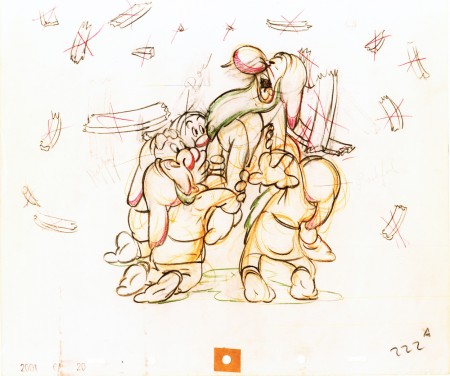
Here is a scene from Snow White, animated by Bill Tytla, in which four of the dwarfs fight Grumpy. The drawing above is the first of these drawings and it shows what it looked like in color – lots of red pencil notes, yellow pencil for rough structural lines. The rest of the drawings I have are B&W copies.
By the way, if you like this material check out Hans Perk ‘s site today. It deals with forces vs. forms in animation. This is what Tytla was all about in animating.
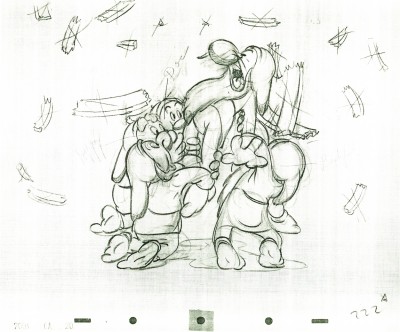 222
222(Click any image to enlarge.)
 223
223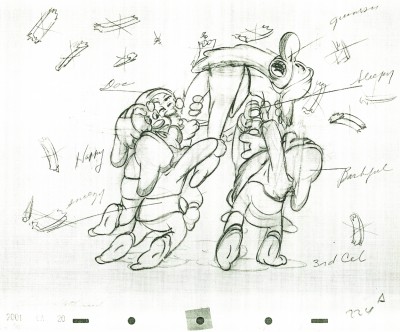 224
224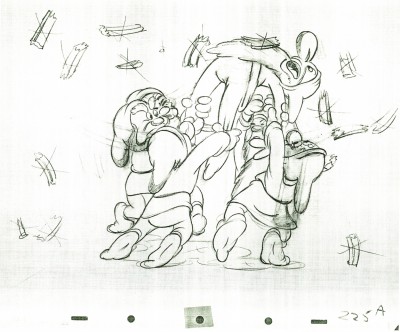 225
225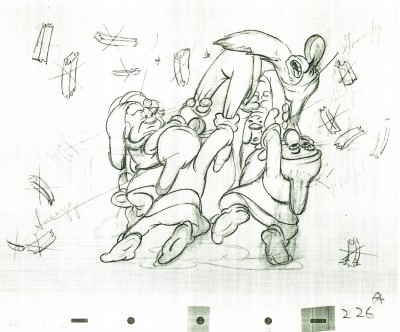 226
226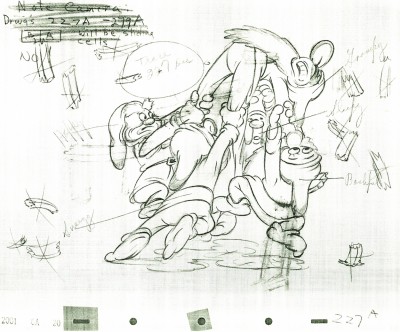 227
227Check out Happy’s face on this inbetween.
Then check out Tytla’s drawing (the next one) of Happy.
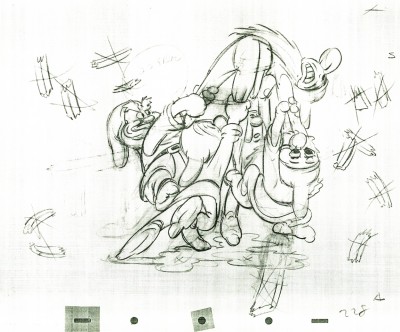 228
228
Tytla marked his own drawings with an “X” in the upper right corner.
The other drawings are the work of inbetweeners. The writing looks
to be all the work of Tytla.
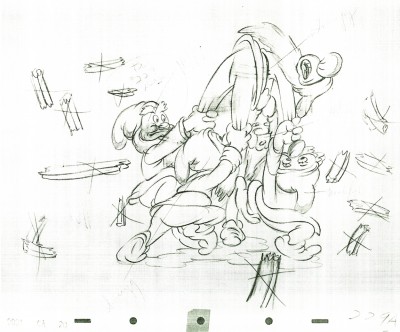 229
229
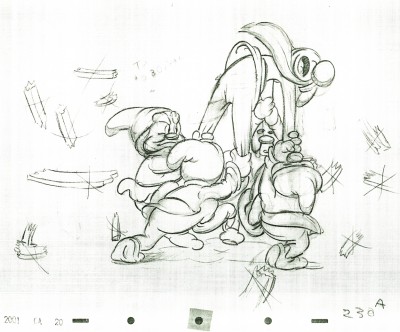 230
230
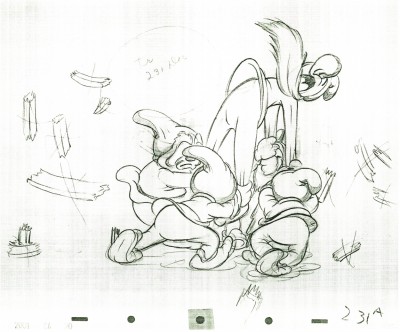 231
231
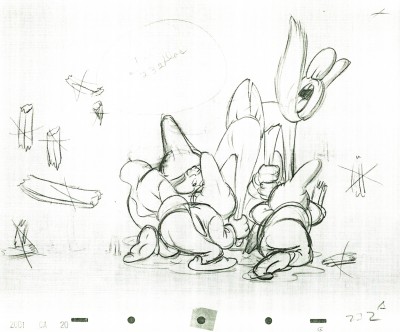 232
232
 233
233
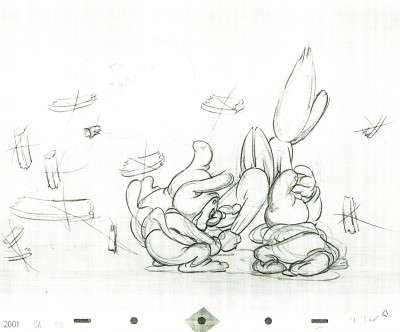 234
234
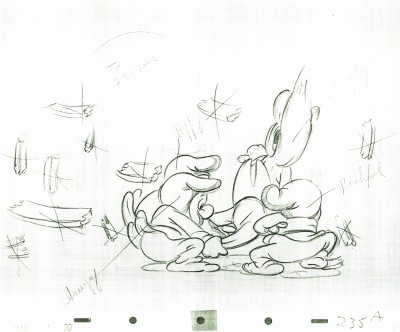 235
235
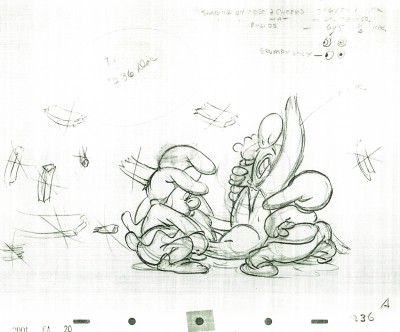 236
236
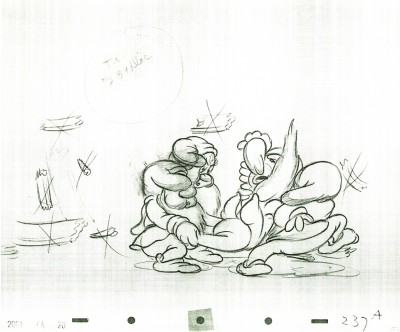 237
237
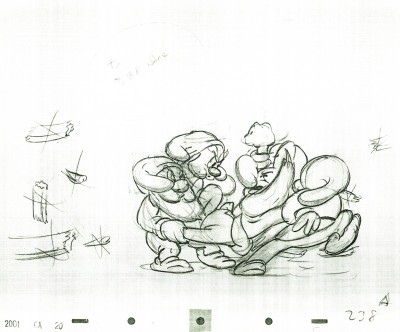 238
238
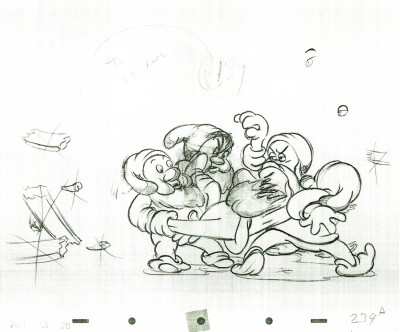 239
239
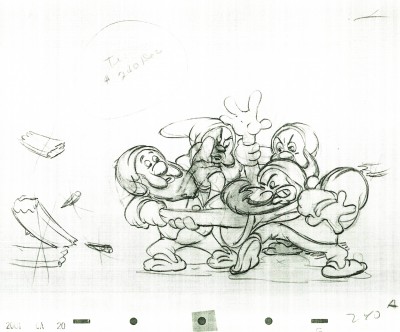 240
240
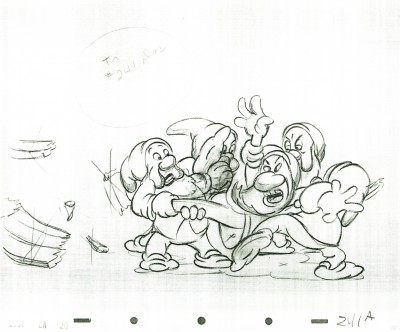 241
241
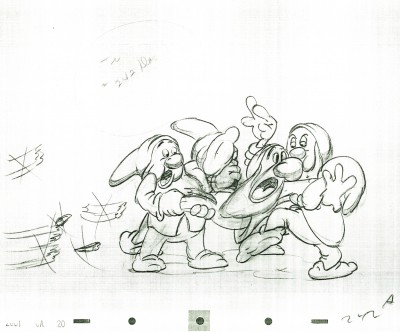 242
242
Some of these drawings are just hilarious in their own right.
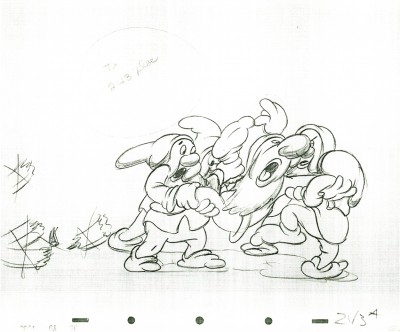 243
243
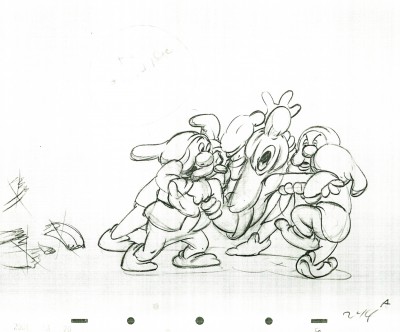 244
244
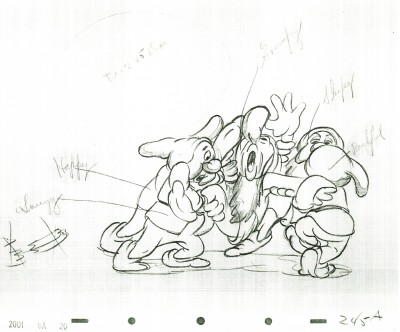 245
245
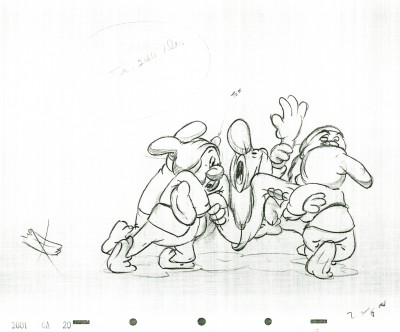 246
246
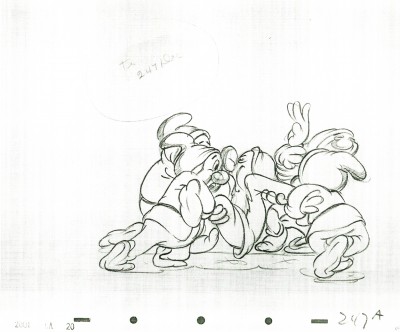 247
247
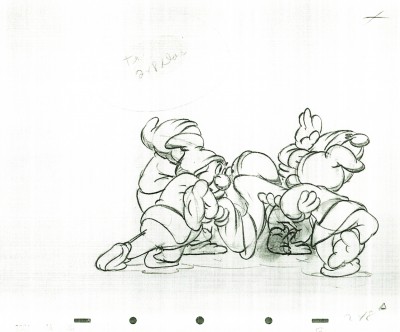 248
248
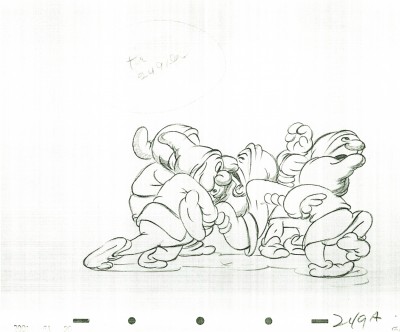 249
249
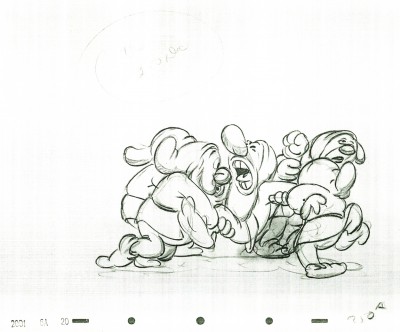 250
250
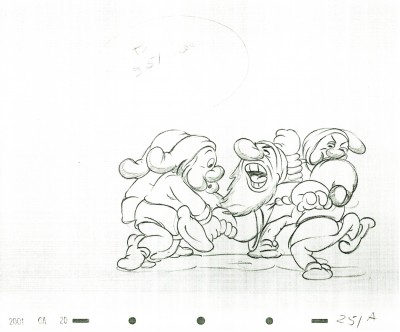 251
251
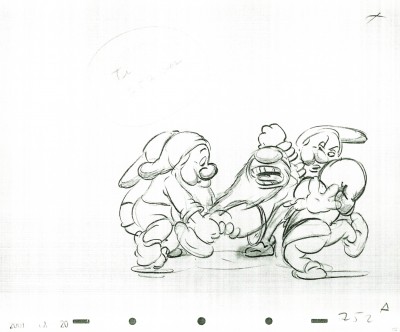 252
252
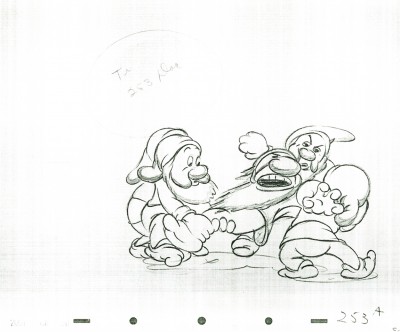 253
253
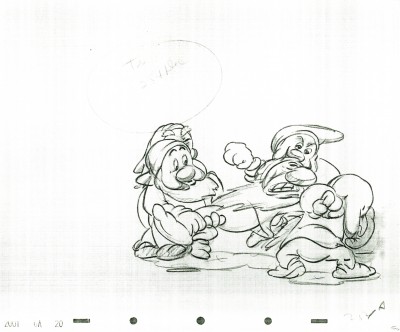 254
254
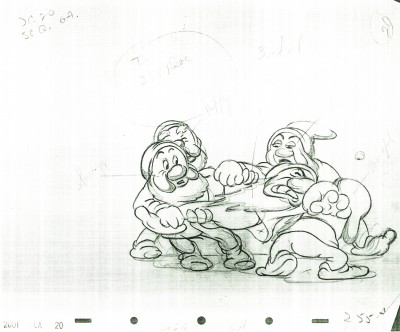 255
255
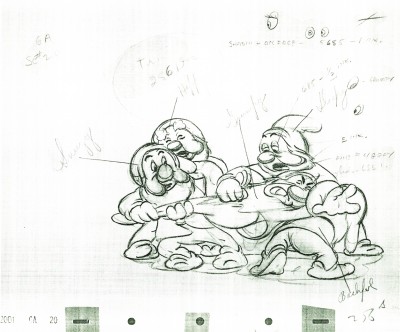 256
256
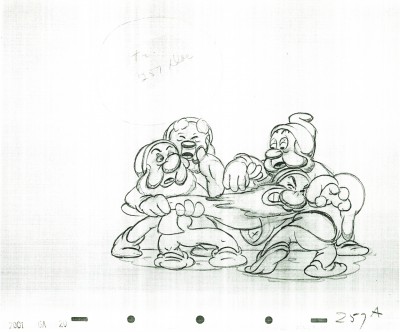 257
257
 258
258
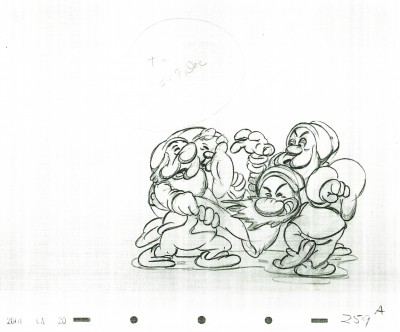 259
259
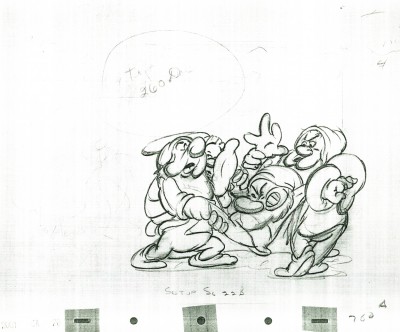 260
260
Click the black bar on the left to play.
Click on the right to single frame it.
